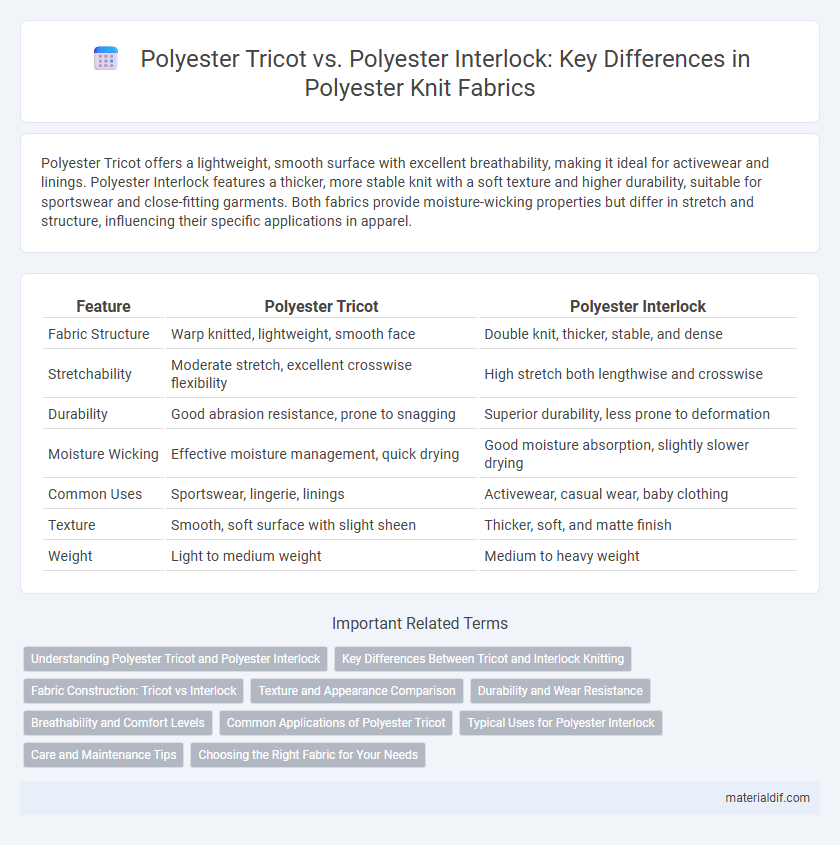Polyester Tricot offers a lightweight, smooth surface with excellent breathability, making it ideal for activewear and linings. Polyester Interlock features a thicker, more stable knit with a soft texture and higher durability, suitable for sportswear and close-fitting garments. Both fabrics provide moisture-wicking properties but differ in stretch and structure, influencing their specific applications in apparel.
Table of Comparison
| Feature | Polyester Tricot | Polyester Interlock |
|---|---|---|
| Fabric Structure | Warp knitted, lightweight, smooth face | Double knit, thicker, stable, and dense |
| Stretchability | Moderate stretch, excellent crosswise flexibility | High stretch both lengthwise and crosswise |
| Durability | Good abrasion resistance, prone to snagging | Superior durability, less prone to deformation |
| Moisture Wicking | Effective moisture management, quick drying | Good moisture absorption, slightly slower drying |
| Common Uses | Sportswear, lingerie, linings | Activewear, casual wear, baby clothing |
| Texture | Smooth, soft surface with slight sheen | Thicker, soft, and matte finish |
| Weight | Light to medium weight | Medium to heavy weight |
Understanding Polyester Tricot and Polyester Interlock
Polyester Tricot features a smooth, lightweight knit characterized by fine mesh construction, offering excellent breathability and stretch, making it ideal for activewear and linings. Polyester Interlock is a thicker, double-knit fabric with a smooth surface on both sides, providing greater durability, insulation, and shape retention for sportswear and casual garments. Understanding the key differences in texture, weight, and performance between Polyester Tricot and Interlock helps in selecting the right fabric for specific clothing applications.
Key Differences Between Tricot and Interlock Knitting
Polyester Tricot features a smooth, fine knit with a slight diagonal rib pattern, offering excellent stretch and recovery ideal for activewear and lingerie. Polyester Interlock, characterized by a thicker, double-knit structure, provides enhanced durability, warmth, and a more stable fabric with minimal stretch, commonly used in sportswear and casual garments. Key differences lie in texture, elasticity, and application: Tricot is lightweight and flexible, while Interlock is heavier and structurally firmer.
Fabric Construction: Tricot vs Interlock
Polyester Tricot features a warp-knit construction characterized by fine, smooth loops that create a lightweight, breathable fabric with excellent stretch and recovery, making it ideal for activewear and lingerie. Polyester Interlock, crafted with a double-knit construction, results in a thicker, more durable fabric with a smooth surface on both sides and enhanced stability, often used in athletic apparel and casual wear. The distinct knit structures influence their durability, stretch, breathability, and texture, guiding fabric choice based on end-use requirements.
Texture and Appearance Comparison
Polyester tricot features a smooth, lightweight texture with a subtle sheen, making it ideal for sportswear and lingerie due to its breathability and durability. Polyester interlock, on the other hand, offers a thicker, more stable knit with a soft, slightly matte finish that provides better insulation and shape retention. The distinct difference in texture and appearance influences their suitability for different apparel applications, with tricot favoring fluidity and interlock offering structure.
Durability and Wear Resistance
Polyester Tricot features a smooth, lightweight knit with excellent durability, making it ideal for activewear that undergoes frequent movement and stretching. Polyester Interlock offers a thicker, more tightly knit structure that enhances wear resistance and maintains fabric integrity under heavy use and repeated washing. Both fabrics provide strong abrasion resistance, but Interlock's denser construction typically results in superior longevity for garments exposed to rigorous wear conditions.
Breathability and Comfort Levels
Polyester tricot features a loose knit structure that enhances breathability, making it ideal for activewear and sports clothing by allowing better air circulation. Polyester interlock, with its tighter knit, offers superior durability and a smoother surface but reduces airflow, which can decrease overall comfort in warm conditions. Choosing between the two depends on the desired balance between ventilation and softness, with tricot excelling in moisture management and interlock providing a more stable, soft feel.
Common Applications of Polyester Tricot
Polyester tricot fabric is widely used in activewear, lingerie, and sports jerseys due to its lightweight, breathable, and smooth surface that offers excellent stretch and moisture-wicking properties. Its fine, closed-knit structure provides durability and resistance to wrinkles, making it ideal for swimwear linings and performance apparel. Compared to polyester interlock, tricot excels in applications requiring flexibility and quick drying.
Typical Uses for Polyester Interlock
Polyester interlock fabric is commonly used in activewear, sportswear, and children's clothing due to its smooth texture, durability, and excellent stretch recovery. Its double-knit construction provides enhanced elasticity and shape retention, making it ideal for garments requiring comfort and flexibility. The fabric's breathable and moisture-wicking properties also contribute to its popularity in performance apparel.
Care and Maintenance Tips
Polyester tricot offers a lightweight, durable fabric that requires gentle machine washing with cold water to maintain its elasticity and vibrant color, while avoiding high heat during drying prevents fiber damage. Polyester interlock, known for its thicker and stretchier knit, benefits from similar care but needs extra attention to avoid fabric pilling by using mild detergents and washing inside out. Both fabrics are resistant to shrinking and wrinkling, making air drying or low-heat tumble drying the best methods to prolong garment lifespan.
Choosing the Right Fabric for Your Needs
Polyester Tricot offers a lightweight, smooth texture ideal for activewear and lining, delivering excellent breathability and flexibility. Polyester Interlock provides a thicker, more stable knit with a soft hand feel, making it suitable for structured garments and casual wear requiring durability. Selecting between these fabrics depends on the desired balance between stretch, weight, and garment functionality.
Polyester Tricot vs Polyester Interlock Infographic

 materialdif.com
materialdif.com